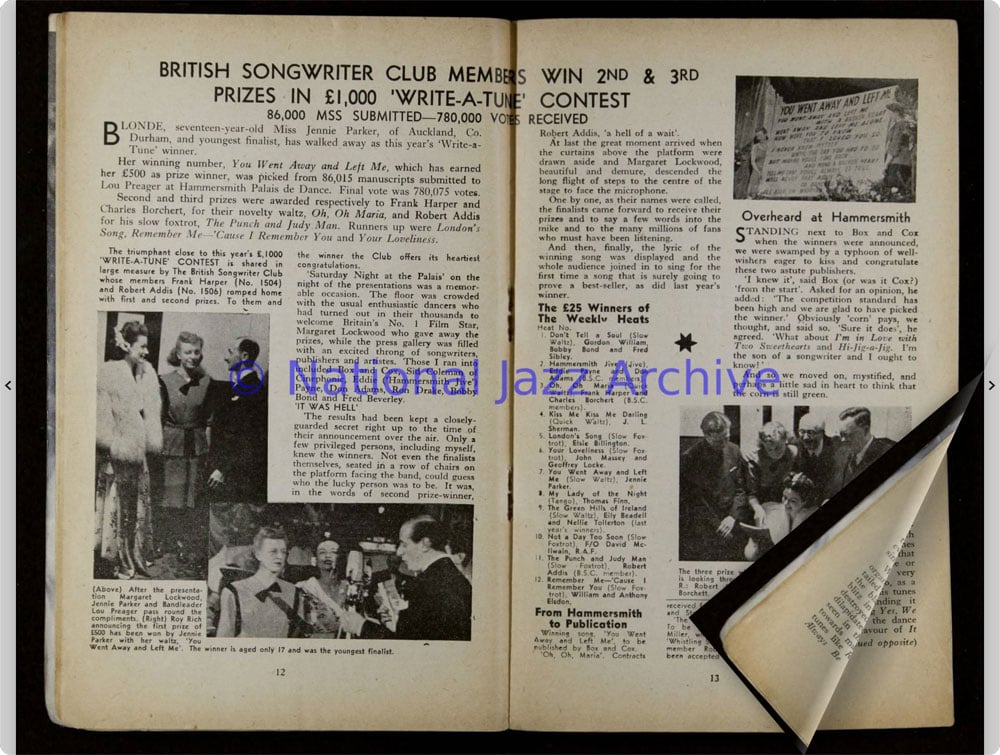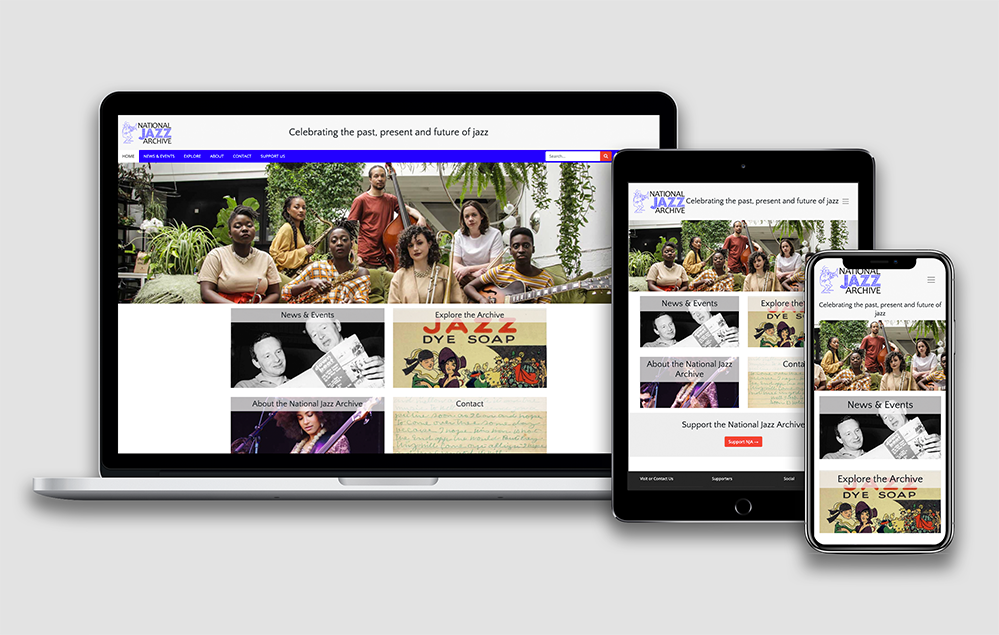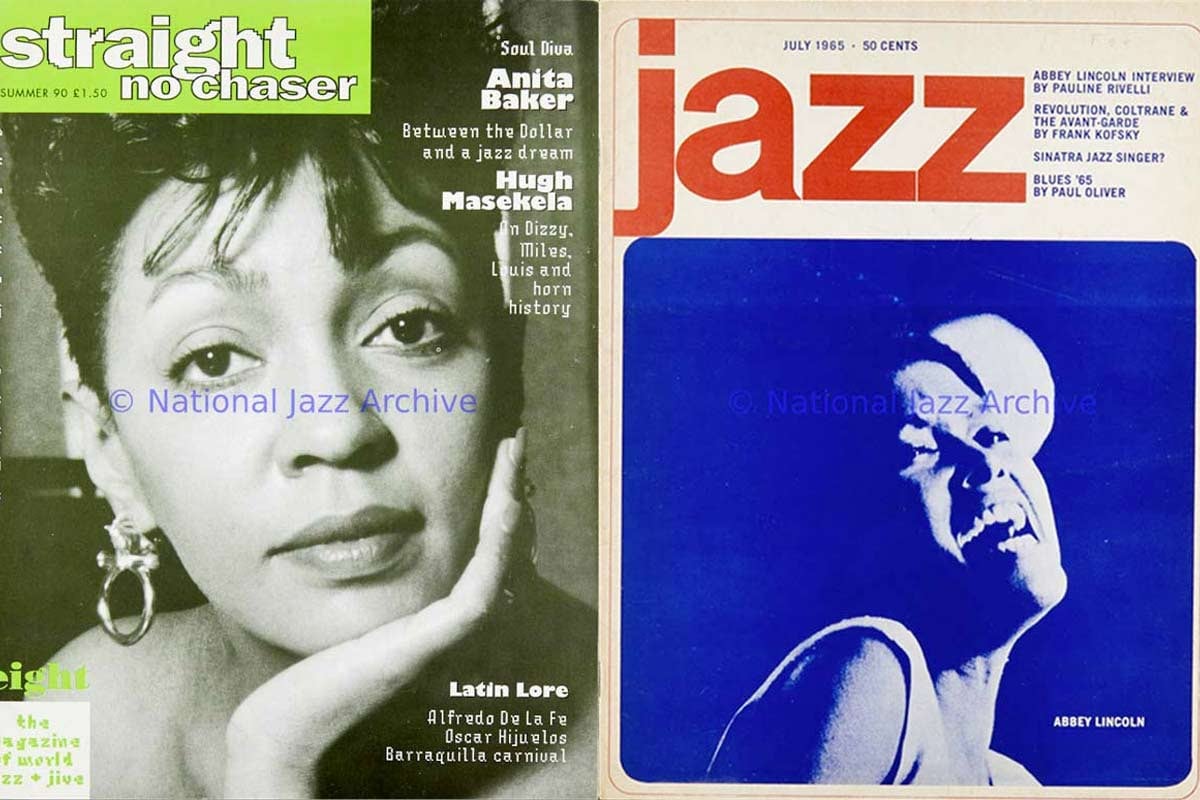There is conflicting opinion around when exactly jazz emerged and to whom, specifically, credit should be given for the creation of this uniquely soulful art and sound. It has long influenced, and been influenced, by a style and culture driven by the 1920’s post WW1 period. A time where fashion became more liberal, reflecting clothing that challenged the more traditional and somewhat restrictive attire, allowing for the freedom necessary for movement, music and dance.

The National Jazz Archive, founded by Digby Fairweather in 1988, sought to collect jazz related content as a tribute to the significant influence it has had on our cultural heritage, protecting it for current and future generations of jazz enthusiasts. With books, journals, magazines, periodicals, newsletters, photos, drawings and paintings, The National Jazz Archive is testament and home to the UK’s most enviable collection. Jazz has evolved exponentially over the years, and the way people access and listen to it has changed beyond all recognition. It has never been easier to browse and explore music and this means greater exposure to a much wider and more diverse audience. In fact, according to The Guardian, we are heading for a UK jazz renaissance. It seems the younger generations are discovering jazz much earlier in their consumer careers...and they’re loving it!
Consequently, John Dale, Trustee at the National Jazz Archive, consulted TownsWeb Archiving on behalf of the archive because, although times had clearly changed, the website had not.
.png?width=290&name=pasted%20image%200%20(1).png) As a result, the valuable service the archive offered was not quite what they wished it to be. Current systems had become dated and complex, and were not mobile friendly at all. The earlier website had originally been created through funding from the Heritage Lottery Fund, to support the ‘Story of British Jazz’ project, and it had served its purpose well, but a complete refresh was about due.
As a result, the valuable service the archive offered was not quite what they wished it to be. Current systems had become dated and complex, and were not mobile friendly at all. The earlier website had originally been created through funding from the Heritage Lottery Fund, to support the ‘Story of British Jazz’ project, and it had served its purpose well, but a complete refresh was about due.
The overall objective was to concentrate on the three strands currently in operation (the online catalogue, digitised collections and the website) with a view to achieving the following outcomes:
1. To bring the three elements together to enable users to search multiple avenues via one single archive
2. Publish as one archive through the PastView platform, reducing multiple hosting running costs
3. A unique website design for a unique archive, enhancing the user experience and opening access to collections
1. When 3 become 1 - Bringing the three elements together via one single archive
The National Jazz Archive website previously had three strands, requiring three different searches to be performed, depending on what users were looking for. This proved time consuming and frustrating, as well as complicated. The viewing experience for researchers, jazz enthusiasts and musicians was not what it could be, not to mention that hosting through three different servers is a very costly business. It was clear that the system needed a revamp. The rich and culturally significant content had earned it and those faithfully committed to the jazz movement deserved it.
In relation to the catalogue, this meant creating an ‘import’ mechanism as an online solution for displaying the existing searchable data. TownsWeb Archiving uploaded the first version, by way of an example, and then delivered training to the National Jazz Archive staff so that they could perform this function efficiently and effectively.
.png?width=741&name=unnamed%20(1).png)
Moving this stage forward themselves meant they would have the flexibility to continue as and when time allowed, while reducing project costs by only paying for the services they really needed. National Jazz Archive visitors could look forward to accessing and viewing the digital collections and catalogue data in a single place, as well as browse up-coming events on the website.
The current system for organising collections was complicated and there was potentially a clearer and more user friendly way to do this. Consequently, collections were placed into a ‘Collection Folder’, specifically created for and aimed at jazz enthusiasts, then subdivided into material types, such as ‘programmes’.

Subdividing collections, for example ‘photographs’, meant that visitors could search and browse for a set venue, irrelevant of date, or all photos within a given year. Search options had just become much more diverse, meaning the National Jazz Archive could organise their content more efficiently with visitors reaping the benefits in quantity and quality.
Connecting the Items within Collections

PastView’s intelligent ‘tagging’ feature serves to link all related items together for a more comprehensive and detailed search with a higher quality user experience. This requires an update in terminology and a new way of understanding how content is uploaded, stored, managed and retrieved.
Within PastView, all people are referred to as ‘entities’ and every individual item within the database, whether that be a journal, photograph or anything else, can be tagged with all terms to which they may relate, building relationships between items and making it easier to group them together in a number of different ways.
So, this is how it works:
Referring to people as ‘entities’, makes it easy for PastView to locate a particular person in any number of places - it might be a photograph of them or it may be a reference to them in a review or article.
As for individual things within collections, they are referred to as ‘items’ and each is issued with an ‘Attribute Set’: all of the words (or ‘fields’) that make up the data for that particular item. It might be the date, the format of the original material e.g. ‘photograph’, or any other detail that might best qualify or describe it. This Attribute Set is what powers the search, driving PastView to gather everything with the specified attributes and presenting the user with every related item. It’s then down to them to pick and choose which best suits their research needs. This means a much more comprehensive search return.
Here endeth the lesson, but it isn’t about changing the language to create confusion. Rather, the terminology aids a search facility that has proved, time and again, to be exceptionally sleek, super organised and thorough.
For the National Jazz Archive this means that the 23,770 items (such as journals, magazines and images) and the 8,995 entities are now linked together easily through the 1,255 collections. With this volume of content, it’s easy to see how the return for the National Jazz Archive visitors is now greater than it has ever been before.
"The improvement in searching has been tremendous. The good feedback we get from users about searching the new site has really made the update worthwhile. It has also made us think more about attributes we have associated with items, so as we improve these the search results that users get will also improve."
John Dale, Trustee at the National Jazz Archive
2. Publishing as one archive through the PastView platform
.png?width=1600&name=pasted%20image%200%20(2).png)
Before PastView the current search results returned three items in a half page row and it was felt that this could be adapted. The National Jazz Archive wished to take full advantage of their vibrant content, with images to be larger and for search results to span the whole page. The search works extremely well for those users of mobile phones and tablets and each item now contains social media functionality, so users can share content within their community and engage through comment and discussion. As a result, the National Jazz Archive can more easily track how their visitors interact and communicate with them through social media.
3D Book Explorer

PastView also enabled the National Jazz Archive to implement other exciting features, such as the fabulous Book Explorer with its powerful Optical Character Recognition (OCR) system. This identifies text within documents, which can be used as metadata for search fields. When these fields are searched the OCR system returns more accurate and fuller searches.
With such large collections of typed journal content, the best method of displaying, browsing and searching was to utilise our 3D Book Explorer, with page turning facility. Visually appealing, with whole page presentation and huge functionality, this feature enabled researchers to keyword the whole collection of "JAZZ NEWS" for a particular decade, year or volume. The result flicks through the journals and takes the user straight to the correct page, highlighting exactly what they are looking for... easy!
Now collections, such as programs, ephemera and journals, can be displayed in high resolution, offering the look and feel of something more physical and glossy - optimising visitor interaction and experience.
Audio & Transcription
.png?width=1600&name=pasted%20image%200%20(3).png)
And for those visitors seeking to sit back and listen, they can now enjoy exploring a vast collection of interviews in audio format and, thanks to audio transcriptions, search these collections to find exactly what they are looking for.
Timeline
.png?width=1600&name=pasted%20image%200%20(4).png)
A timeline was also created in order to offer visitors yet another way to browse and access the collections and the items within them. This has proven to be a fantastically visual, informative and vibrant way of plotting the history and journey of jazz.
Data Protection
To guard against copyright infringement, all images were watermarked and protected through IP addresses, setting the system to allow access to specific collections within certain locations. So if a search is conducted outside of the National Jazz Archive then a thumbnail will appear informing the user where they will find the information they are looking for. They will then have to visit the National Jazz Archive in order to access it. This is key to ensuring that ultimate possession and control remains with the National Jazz Archive at all times, thereby safeguarding the repository that Fairweather had so avidly created and intended.
“The 3D Book Explorer is a great feature. It now gives users the feel of being in the archive, turning the pages of the journal or programme they are viewing. Together with the link to search, highlighting where the search term appears on the page, and the magnifying loupe, research is now so much easier.”
John Dale, National Jazz Archive
3. A unique website design for a unique archive
It was very important that the National Jazz Archive be recognised for its originality and so a bespoke website was created to take account of existing branding and style, with a move towards something quite modern and fresh. Casper Smithson, digitisation consultant for TownsWeb Archiving, offered his expert knowledge and advice around creating something tailor-made; something that harnessed the National Jazz Archive’s vision. This is something TWA considers to be dedicated time very well spent. In terms of getting the look and feel right, consultations resulted in the following specifications:
1. It was decided that the new site would not feature the existing sidebar but, instead, an easy scrolling option would be created. The National Jazz Archive were also keen for the logo to be present and visible to visitors at all times, and for the images displayed to represent jazz in both the past and present. The look is now bright, fresh and visually striking.
2. The National Jazz Archive wanted their website to be sleek and accessible to all, moving with the times, so we created a site that was mobile responsive; whether accessing the archives through ipads, phones or laptops, the look and feel is always professional, engaging and entirely user friendly. This means a search facility that enables access in a way that best suits today’s visitors.

3. The National Jazz Archive also wanted visitors to be able to share what they had found with others; promoting archive content more readily and easily through social media. This was made possible through the addition of quick links to the main social media channels, visually bringing the website in line with today’s user experience, modern social behaviours, and expectations.
4. It’s also very important for TownsWeb Archiving that clients receive the flexibility of a bolt-on option to existing websites, or a unique and fully functioning website. The latter is what the National Jazz Archive were keen to achieve. With that at the forefront, they were given scope to design a number of CMS pages, such as ‘About’, ‘Explore’ and ‘Support Us’, to enable them to manage their related content and display it, adding news and events as they wish.
“We have so much more control over the content of our website now. This makes it easier for us to keep it fresh and ensure that users keep returning. Working across all platforms, including mobile platforms, makes sure that the website has the widest appeal to the widest of audiences.”
John Dale, National Jazz Archive
The final result has been something quite beautiful and in keeping with the more modern look and feel of the National Jazz Archive and its commitment to maintain archives of great heritage and national importance, enabling them to share their content more widely and easily with their dedicated followers and visitors. Bringing the physical into digital format has created the opportunity to harness the power and breadth of connecting material, thereby enhancing the user experience.
But don’t just take our word for it, visit their new and quite wonderful website here and take a look for yourself.
Contact
If the early issues faced by the National Jazz Archive relate to your own circumstances, and you would like to know more about publishing digitised content or, indeed, the digitising of that content, then please do make contact with us here at TownsWeb Archiving. Our Digitisation Consultants will be happy to run through your individual needs and advise on how best we can help.
We look forward to hearing from you.



